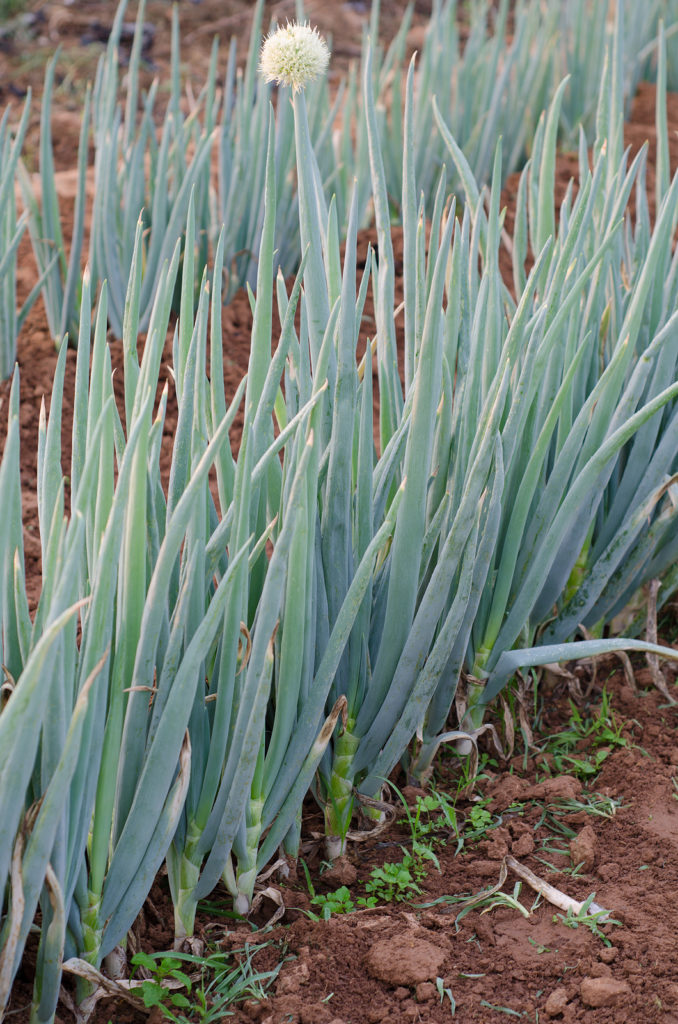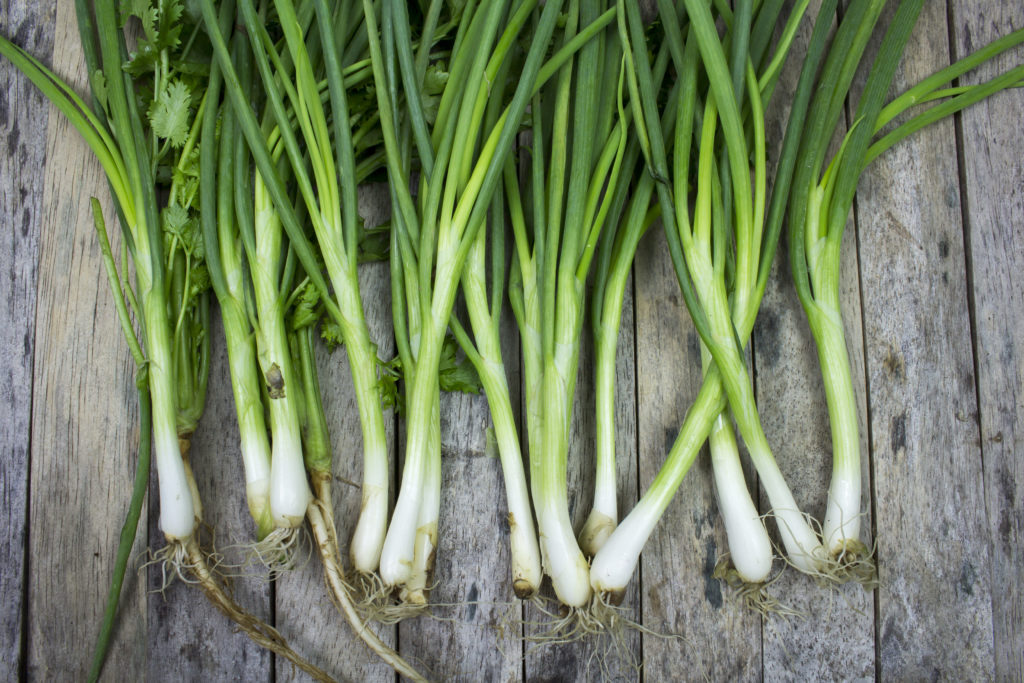Welsh onions are easy to grow. They are cool-season crops. They are best planted in spring or autumn.
Welsh onions are mild-flavored members of the onion family. They can be added raw to salads and soups. They can be stir-fried and sauteed and served with beef or chicken. They can be used as garnish.
Welsh onions are considered non-bulbing onions although their roots will swell slightly if left to fully mature.
Welsh onions are also known as “Japanese onion,” “negi” in Japan, “cong bai” in China, “Japanese bunching onion”, and “ciboules” in France. And they are also commonly called bunching onions, long green onions, and spring onions.
The name Welsh onion is a misnomer; the Welsh onion is not from Wales, it is native to China. “Welsh” is derived from the German word walsch meaning foreign or non-native.
The botanical name of the Welsh onion is Allium fistulosum. (The botanical name of bulbing onions is Allium cepa.) Allium fistulosum does not quickly develop bulbs unless left in the ground for months and months. Allium fistulosum has hollow leaves (fistulosum means “hollow”). Larger varieties of A. fistulosum resemble leeks such as the Japanese negi, smaller varieties resemble chives.
Welsh onions (A. fistulosum) are multiplying onions; they multiply by elongated underground bulbs that replicate to form perennial evergreen clumps.

Planting Welsh Onions
Site
- Plants Welsh onions in full sun.
- Plant Welsh onions in humus-rich, well-drained soil. Add aged compost to the planting bed before planting.
- Loosen the soil several inches deep and enrich each planting hole with compost or work compost into the top several inches of soil.
- In rainy regions or where the soil is slow to drain, plant Welsh onions on mounded or raised beds.
- Welsh onions prefer a soil pH of 6.2 to 6.8.
Tools for Vegetable Gardeners at Amazon:
- A.M. Leonard Straight Rake with Ash Handle
- All-Steel Nursery Spade with D-Grip Handle
- 4-Tine Spading Digging Fork with D-Handle
- Digital Soil pH Meter Outdoors Greenhouse
- Earthwise Handheld Electric Fertilizer Spreader
Planting and spacing seeds
- Direct seed Welsh onions ¼ inch apart in bands 2 to 3 inches (5-7.6cm) wide.
- Thin seedlings to 1 inch apart if you want to harvest large-diameter plants. Seeds can be planted thickly and plants can be thinned by harvesting.
- It takes about 65 days from seed to harvest Welsh onions.
Planting and spacing sets
- In spring and summer, plant onion sets just below soil level and then apply a light compost mulch.
- In fall plant sets 2 to 4 inches (5-10cm) deep and over with several inches of mulch.
- Planting sets will bring a harvest of Welsh onions in a few weeks.
Welsh Onion Planting Times
- Fall-planted, Welsh onions will overwinter in the garden and can be harvested from late winter until late spring at which point they will either form bulbs or bolt. Allium fistulosum is one of the cold hardiest onions; it can withstand temperatures below 0℉ (-17C).
- Spring-planted, they will divide and multiply at the base the following winter; each plant will become 4, 5, or more plants.
- Planted mid-summer, they will be ready for harvest from late winter to late spring.
Spring planting time outdoors
- Sow Welsh onion seeds outdoors as soon as the soil is workable in spring.
- Plant Welsh onions in early spring or in fall. Plant when the soil is workable.
- In a cold-winter region plant Welsh onions in late fall and winter them over; you will have Welsh onions in early spring.
- In mild winter regions, plant sets just below soil level and apply a light mulch.
- Seeds can be planted thickly and thin by harvesting.
- You can also plant onion sets rather than seeds.
Planting time indoors
- Sow seeds indoors 4 weeks or more before the last expected frost in spring. You can begin harvesting indoors or transplant seedling to the garden after the last average frost date.
Succession planting
- Sow Welsh onion seeds every 2 to 3 weeks to ensure continued harvest through the season.
Planting time for autumn and winter harvest
- Sow Welsh onion seeds in late summer or fall so that the seedlings become established before the dormant period. Protect plants through the winter with mulch or grow them under the protection of a plastic tunnel.
Container Growing Welsh Onions
- Grow Welsh onions in a pot that is at least 12 inches (30cm) across and 8 inches (20cm) deep. Scatter seeds and then gradually thin them to about 2 inches (5cm) or more apart.

Caring for Welsh Onions
Watering
- Water Welsh onions often but lightly at the soil level. Avoid wetting the foliage which can lead to disease.
Feeding
- Feed Welsh onions with liquid kelp, fish emulsion, or a balanced organic fertilizer every three to four weeks
Mulching
- Mulch around Welsh onion with aged compost or grass clippings in late spring and summer to conserve moisture and add nitrogen to the soil.
- Mulch Welsh onions with straw in autumn to protect them from cold; this is especially important in Zone 5 and colder.
Weeding
- Remove weeds growing near Welsh onions by hand pulling or cultivating gently to avoid damaging roots.
Welsh onion winter care
- Where the ground freezes in winter, pot up Welsh onion divisions and bring them indoors to a cool, bright spot to overwinter.

Harvesting and Storing Welsh Onions
Harvesting
- Harvest Welsh onions when they are about as thick as a pencil and at least 6 inches (15cm) tall or more.
- Use a trowel to uproot the plants. Avoid pulling on the plants; the stems break easily.
- Harvest as many stems as you need, then replant the cluster if several are uprooted.
- To increase the number of shoots or to start a new clump, separate single shoots and replant them. They will multiply.
- Replant clumps or single shoots in a new spot; this is a form or crop rotation to avoid diseases.
- To harvest Welsh onions at the ideal size, succession plants them.
- Keep harvesting them as needed for fresh eating.
- Harvesting Welsh onions improves the growing conditions for the remaining plants by loosening the soil and removing competition.
Storing
- Welsh onions store best in the ground in the garden; they taste best fresh.
- Welsh onions will keep for about one week in the refrigerator, not longer.
Welsh Onions in the Kitchen
- Welsh onions are mildly flavored.
- They can be served slivered, chopped, or as scallions.
- They can be flavored with sesame oil and soy sauce. They can be served with beef strips.
- They can be made into soup with lemon grass mushrooms, and chicken stock.
- They can be served raw as a salad or combined with cucumbers and vinegar dressing.
Welsh Onion Varieties to Grow
- Varieties include: Evergreen Hardy White, White Spear, Evergreen, Nabechan, Parade, Kujo (Kujyo) Multistalk, Ishikura Long, He-shi-ko, Nebuka, Kincho, Red Beard, Taukuba (a heat-resistant variety grown in spring for summer use), Multi-Stalk, and Tokyo Long White. Hybrids with the common onion (A. cepa) include White Knight, Beltsville Bunching, Guardsman.
- Common name: Welsh onion
- Botanical name. Allium fistulosum (bunching onion, scallion)
- Origin. China
Onion articles at Harvest to Table:
How to Grow Green Onions, Spring Onions, and Scallions
Growing Onion Bulbs: Pick the Right Variety for Your Garden
How to Plant, Grow, and Harvest Welsh Onions
How to Harvest and Store Onions
Onion Family Growing Problems: Troubleshooting
Onion Cooking and Serving Tips
Tasty Ways to Cook and Serve Shallots
How to Make Onion Soup with No Recipe
How to Plant, Grow, and Harvest Shallots
English Peas, Spring Onions and Roasted Almonds
Tropea Onion – The Red Torpedo
Garden Planning Books at Amazon:
- Vegetable Garden Almanac & Planner
- Kitchen Garden Grower’s Guide Vegetable Encyclopedia
- Vegetable Garden Grower’s Guide
- Tomato Grower’s Answer Book














